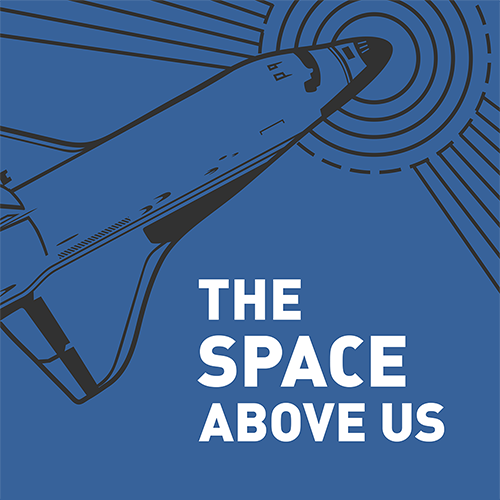Episode 141: STS-63 - Near Mir
Table of Contents
After all this talk about the Russian space station Mir, how about we take a close up look for ourselves? A REALLY close look. Space Shuttle Discovery won’t be the first Shuttle to dock with Mir, but it’ll come close!
Episode Audio #
Photos #
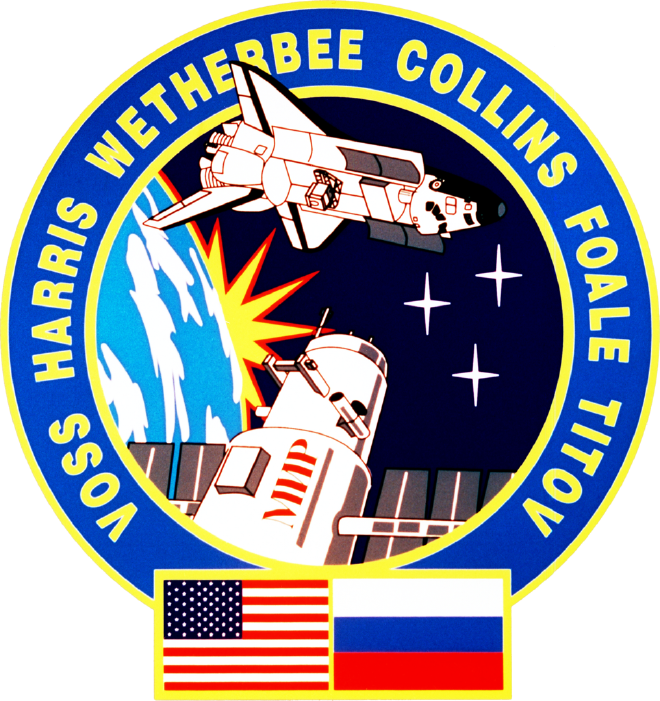
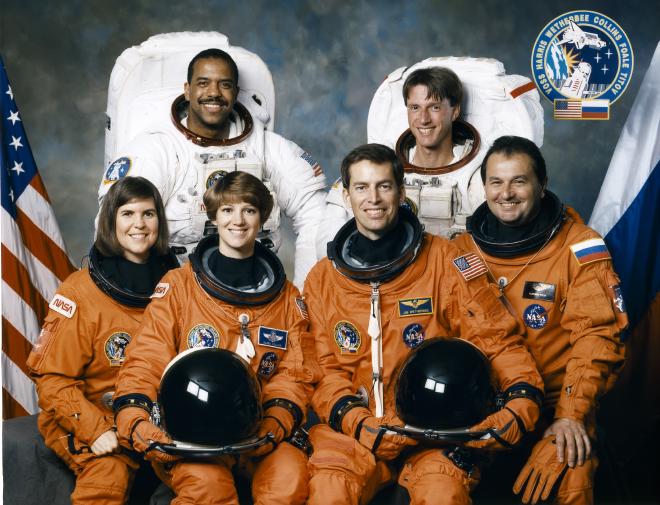
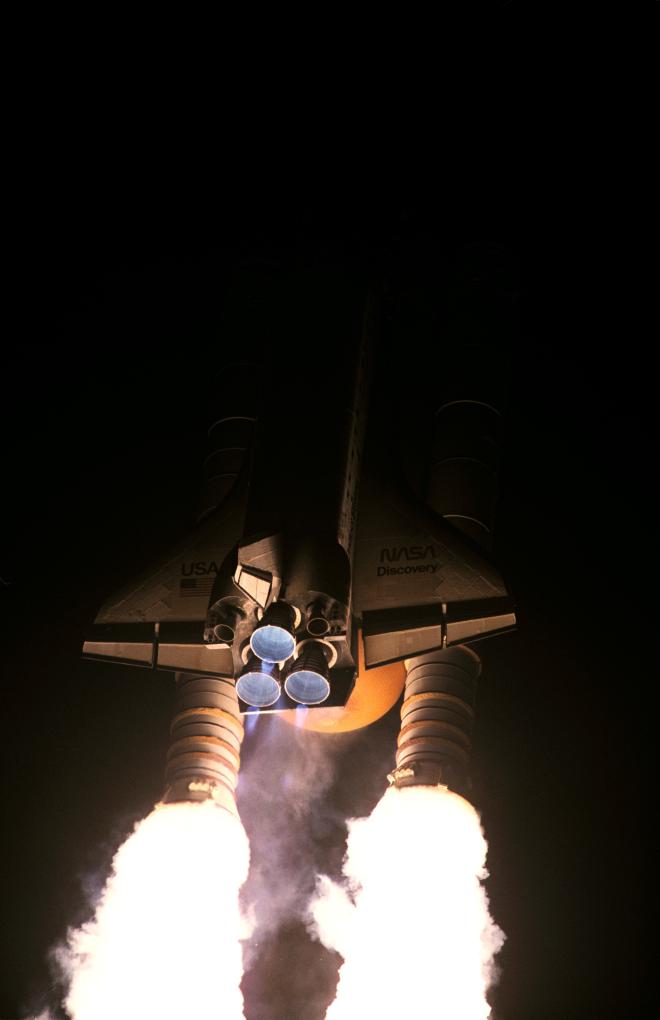
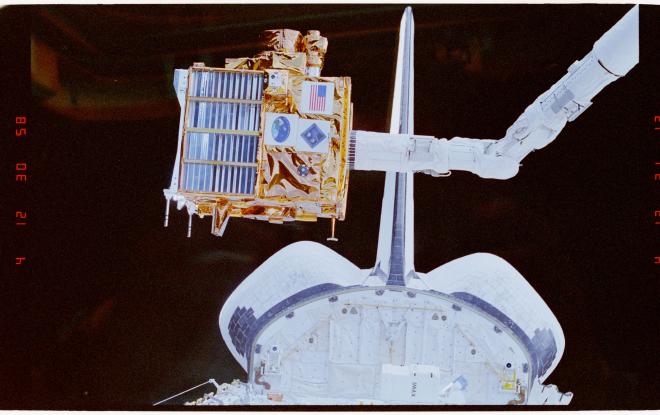
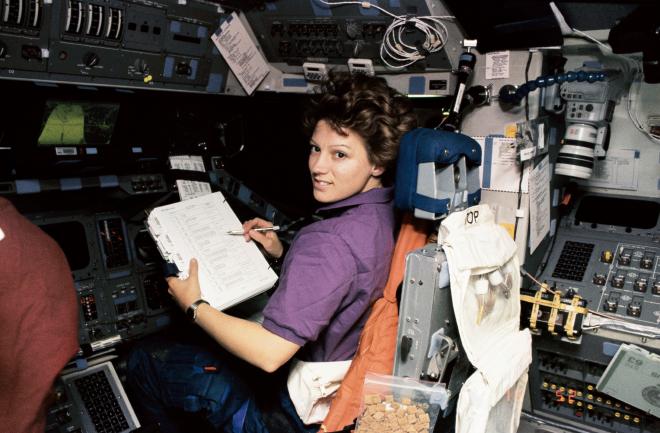
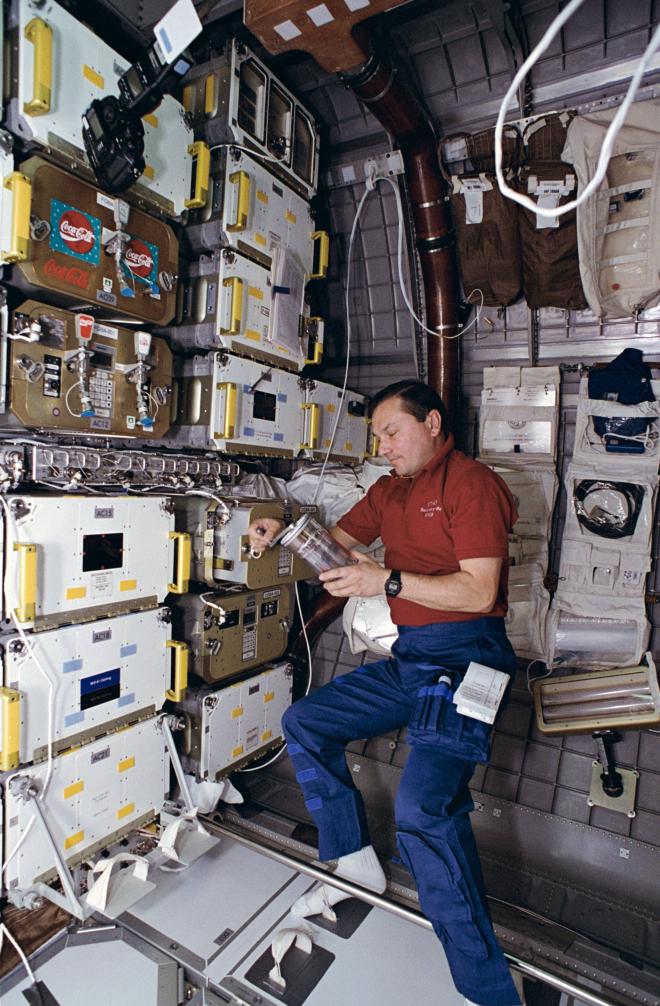
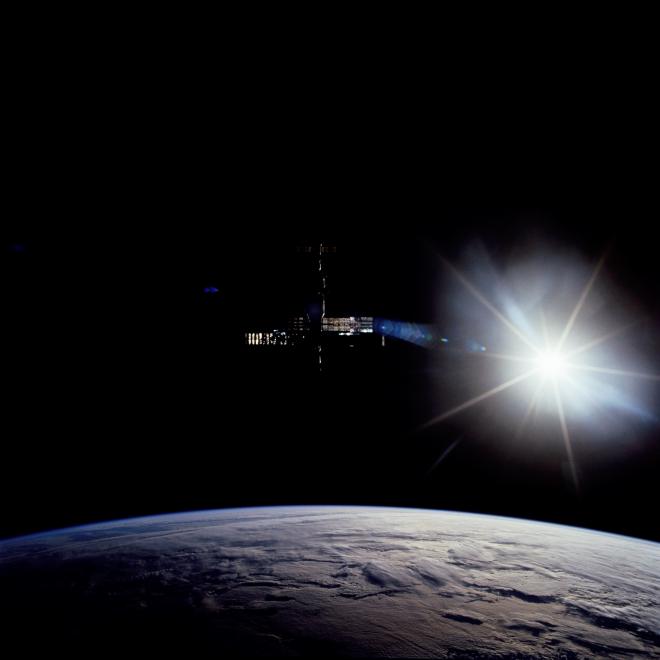
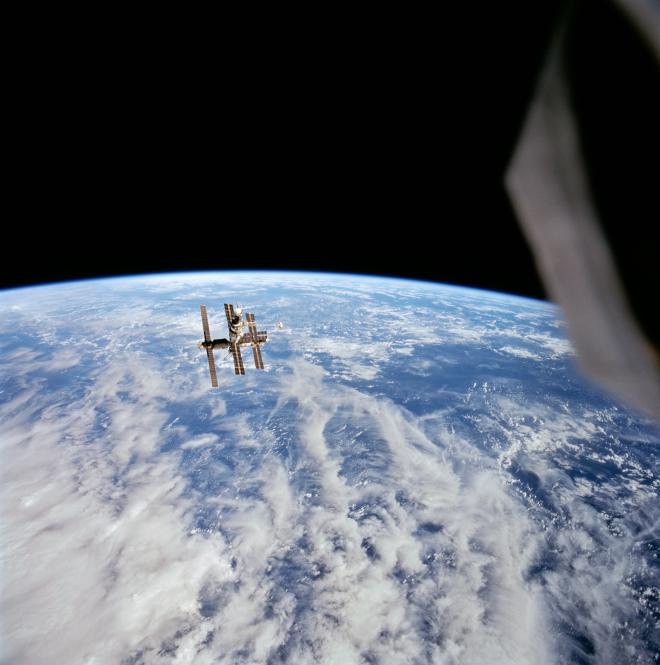
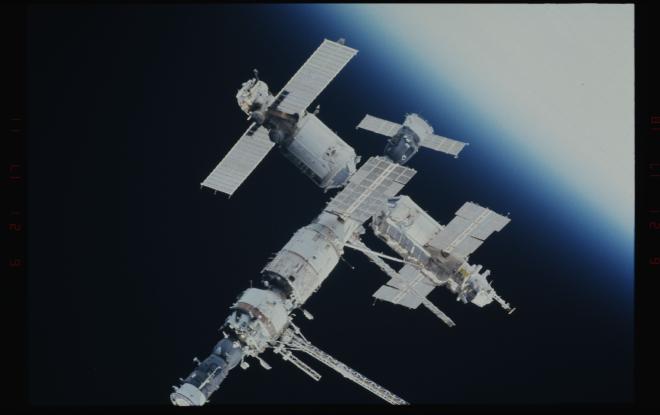
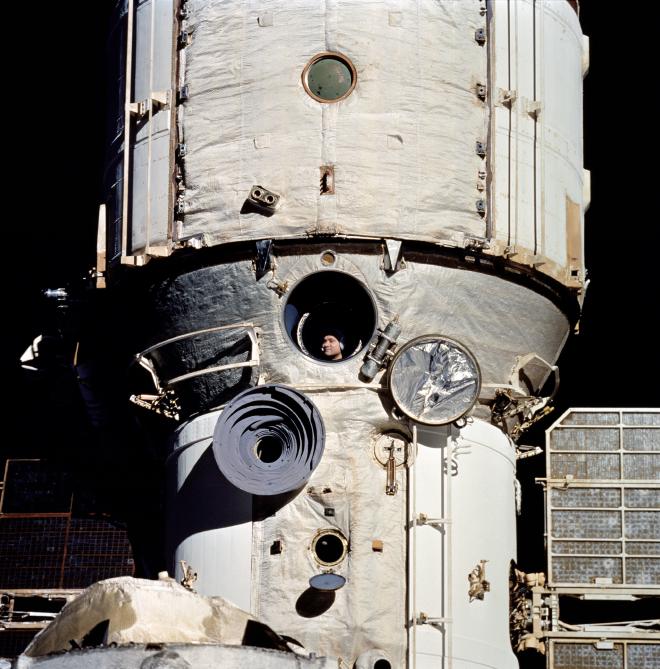
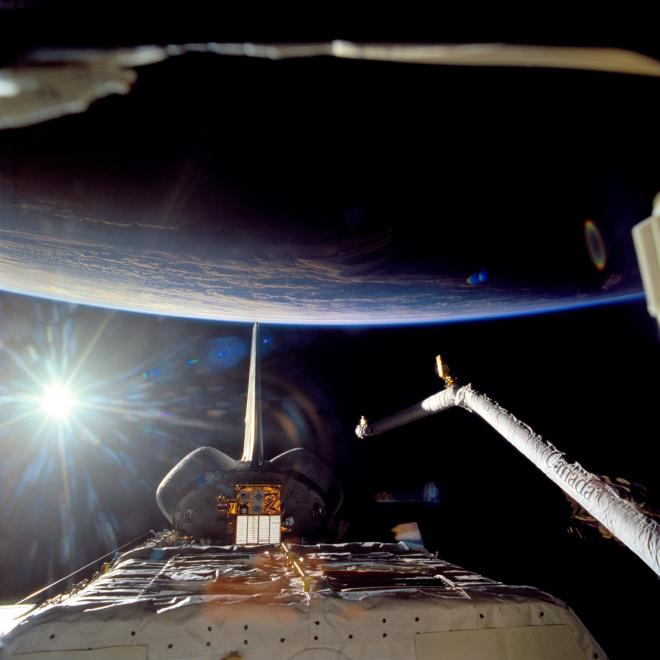
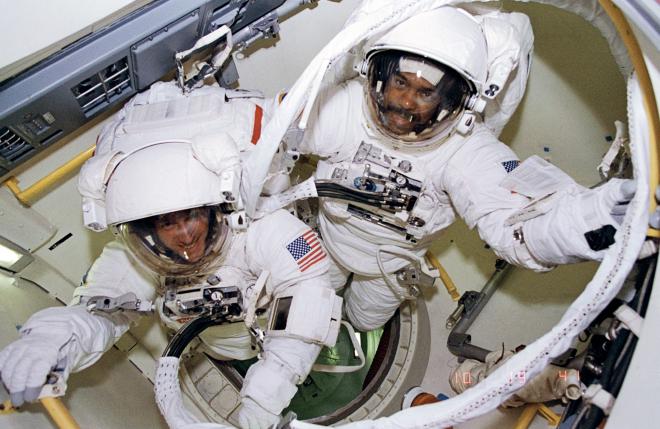
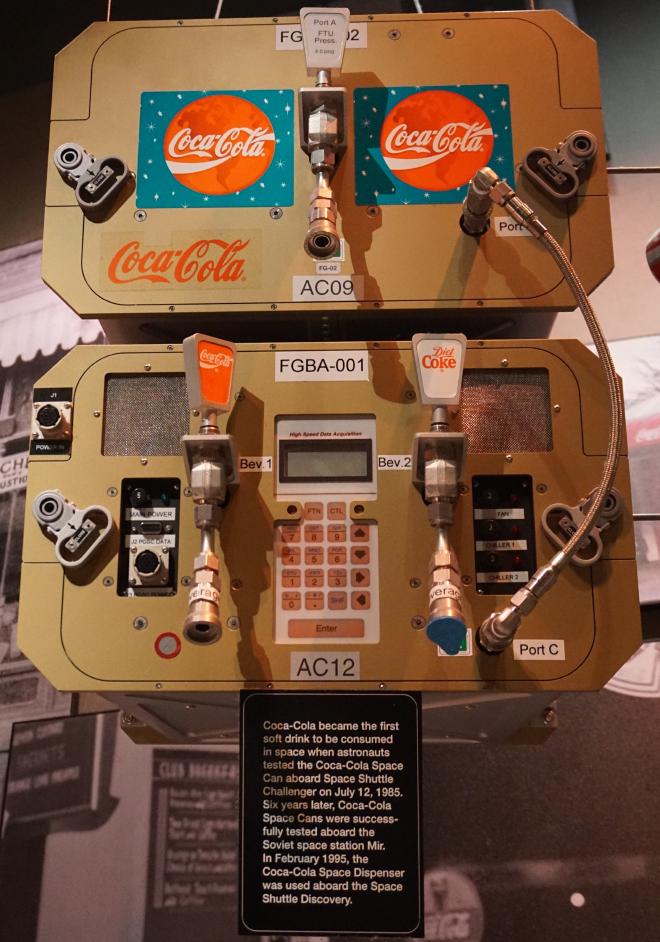
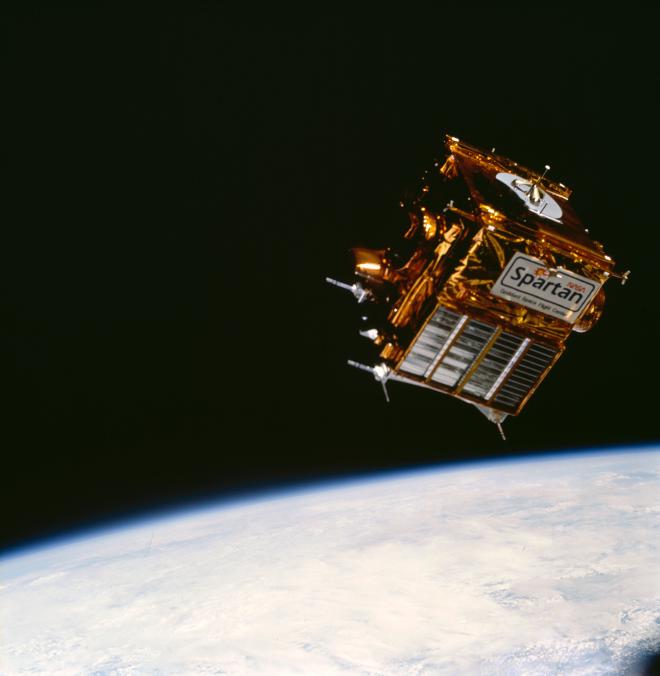
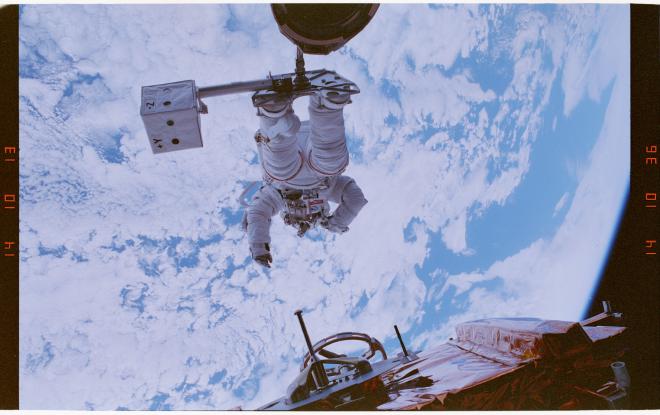
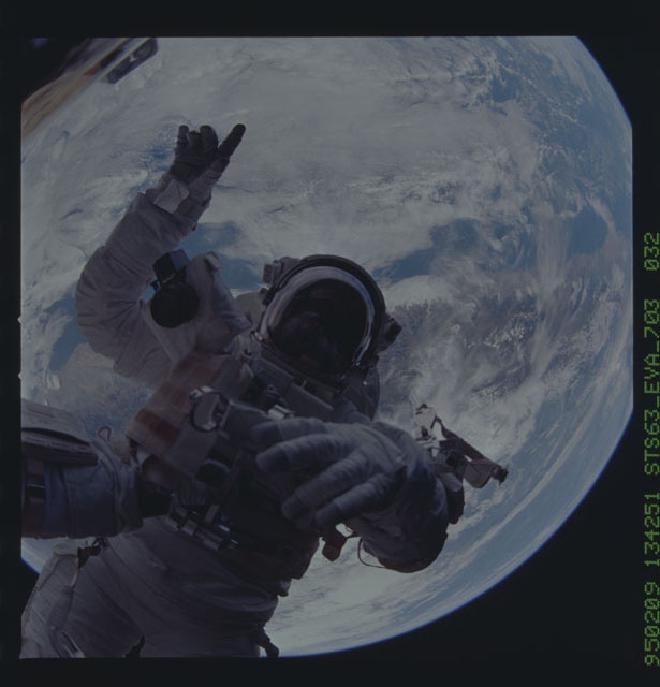
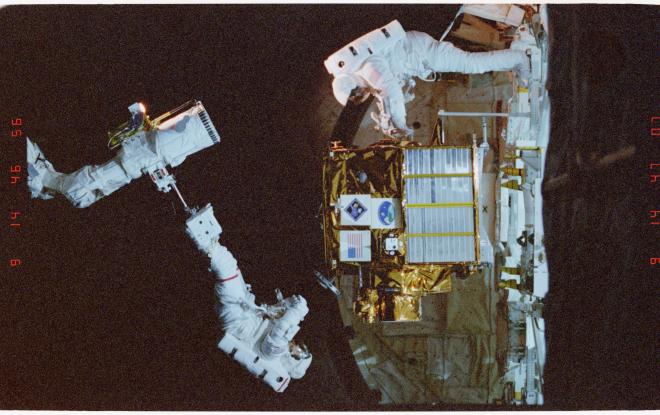
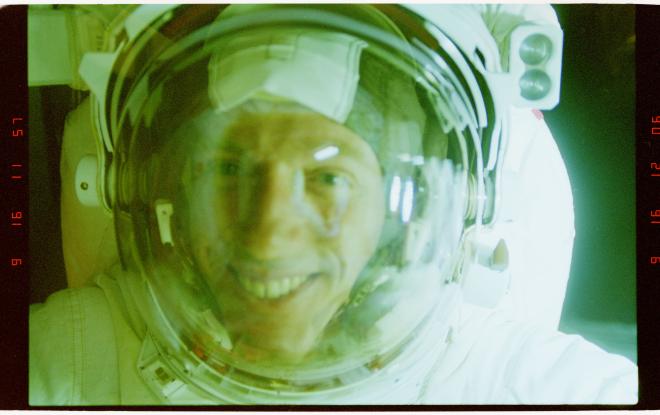
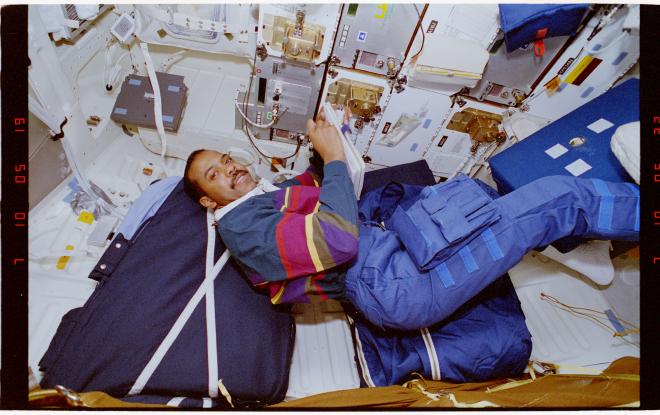
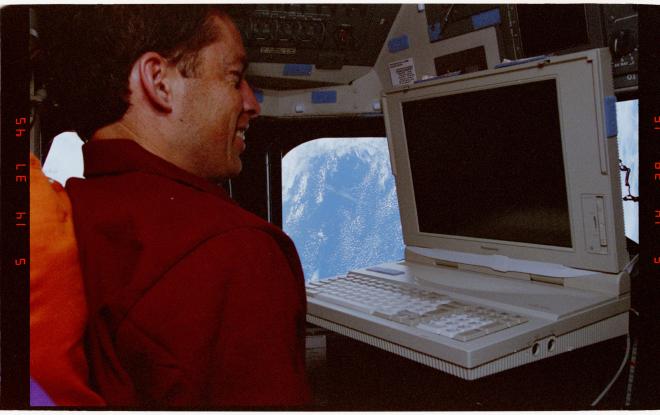
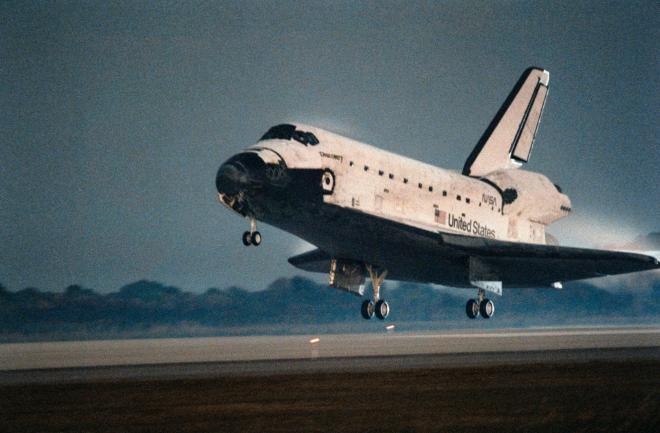
For more photos, head over to our friends at Wikiarchives.space: https://wikiarchives.space/index.php?/category/862
Post-Flight Presentation #
If you’d like to see the mission in motion you can check out the post-flight presentation here:
Mission Highlights Resource Tape #
Ever wanted to watch an hour of B-roll from STS-63? Well now’s your chance!
Transcript #
NOTE: This transcript was made by me just copying and pasting the script that I read to make the podcast. I often tweak the phrasing on the fly and then forget to update the script, so this is not guaranteed to align perfectly with the episode audio, but it should be pretty close. Also, since these are really only intended to be read by myself, I might use some funky punctuation to help remind myself how I want a sentence to flow, so don’t look to these as a grammar reference. If you notice any egregious transcription errors or notes to myself that I neglected to remove, feel free to let me know and I’ll fix it.
Hello, and welcome to The Space Above Us. Episode 141, Space Shuttle flight 67, STS-63: Near Mir
Last time, we talked about Space Shuttle Atlantis’ first flight in more than two years, as it carried a suite of atmospheric instruments into orbit. We also flexed our orbital rendezvous muscles, even trying a new approach by scooting OV-104 up the R-bar of a free-flying payload. We also made fun of a dubiously named payload, and introduced the next batch of men and women joining the astronaut corps.
And actually, I forgot to mention one more thing about STS-66, something that doesn’t really have anything at all to do with the mission itself. When we talked about STS-66 on the previous episode, it was the one hundredth mission covered here on The Space Above Us. And I guess while I’m patting myself on the back for arbitrary milestones, I should also mention that the show’s scripts recently passed 600,000 words in length, which wow. I don’t really have much else to add to that, I just thought that was neat. So thanks for coming along on this ride with me!
An actual noteworthy milestone is that today’s flight, STS-63, marks the first flight of the Shuttle-Mir era. Well, actually, I guess I can’t say that. I already claimed that back on the STS-60 episode, when Sergei Krikalev flew on Space Shuttle Discovery and the shuttle and MIr crews communicated via shared video downlinks. OK fine, this might be the second flight in the Shuttle-Mir series, but for the first time we’re actually going to be seeing the Russian space station up close, and for the first time since the Apollo-Soyuz Test Project, both the American and Russian space programs are going to have to closely coordinate on the ground while their nations’ spacecraft soared in lockstep overhead.
That’s because this flight might as well be the Apollo 10 of the Shuttle-Mir program. The crew of Discovery was tasked with rendezvousing with the Russian space station, flying under it, popping up onto the v-bar, and approaching to within only 10 meters before holding their position, and eventually backing away, flying around the station, and departing. This dress rehearsal for the first docking mission would serve as a valuable test on every aspect of docking other than the docking itself. The rendezvous, the relative motion, the final approach, orbiter to station communications, and Houston to Moscow communications. It was gonna be a heck of a mission. Let’s meet the crew.
Commanding the flight was Jim Wetherbee, flying with us for the third time. When we last saw him, he was commanding STS-52, which sent the geodesy satellite LAGEOS-II into a million year orbit. This flight marks the halfway point in Wetherbee’s six-mission spaceflight career.
Joining Wetherbee up front and flying as today’s pilot was Eileen Collins. Eileen Collins was born on November 19th, 1956 in Elmira, New York. As a kid, she would have had plenty of inspiration for her future career in aviation, thanks to Elmira being a popular location for flying gliders. She earned an Associate’s degree in Math and Science from Corning Community College, a Bachelor’s in Mathematics and Economics from Syracuse University, a Master’s in Operations Research from Stanford University, and a Master’s in space systems management from Webster University. In the midst of all that, Collins also joined the Air Force. Among her many duties with the Air Force, Collins was a T-38 instructor pilot, a C-141 commander and instructor, and an assistant professor and T-41 instructor at the US Air Force Academy. When she applied to become an astronaut, both potential roles interested her, so she applied as both a mission specialist and a pilot. This is her first of four flights.
And I would be remiss if I did not note that Eileen Collins is the first woman to serve as pilot of a space shuttle mission, and she would later go on to command two missions of her own. This is generally mentioned in the first paragraph of any summary of Collins’ time at NASA, but I’ve always been unsure how to handle milestones like this. To me, it almost feels like it’s not noteworthy at all because of course women, and other people who don’t look like the spacefarers of the 1960s, can be astronauts and spacewalkers and space shuttle commanders, that’s obvious. But at the same time it’s apparently not obvious to far too many people. Collins serving as pilot on STS-63 is remarkable in that it was yet another step towards making the flights of the women who would follow in her footsteps unremarkable someday. And I think that’s worth mentioning.
Moving on to the mission specialists, we find Mission Specialist 1, Bernard Harris. Harris joined us on STS-55, the German-funded D-2 mission. Today, rather than spending the whole mission cooped up inside Spacelab, he’ll be heading out into the payload bay for an EVA on this, his second and final flight.
Sitting in the center of the flight deck was Harris’ EVA partner, Mission Specialist 2, Mike Foale. We’ve seen Foale twice now, most recently on STS-56, which carried the ATLAS-2 payload. In fact, since his first mission carried the ATLAS-1 payload, this is his first non-ATLAS mission. I like to imagine he meant to fly on the last mission, which carried ATLAS-3, and just missed. Overall, this is his third of six flights.
Mission Specialist 3 was another friendly face, Janice Voss. When we last flew with Voss, it was on Space Shuttle Endeavour, carrying SPACEHAB into orbit for the first time. Well, now we’re carrying SPACEHAB into orbit for the third time, and Voss for her second of five rides uphill.
With Mission Specialist 4, we again have a crew member who has flown in space before, but who is new to our story so deserves the traditional brief biography. The last time this happened was when we met Sergei Krikalev on STS-60. This makes sense, since Mission Specialist 4, Vladimir Titov, was actually one of two cosmonauts in the running for STS-60, with Titov eventually being assigned as a backup for the flight. Vladimir Titov was born on January 1st, 1947 in Sretensk, in the Chita region of Russia. Titov graduated from the Higher Air Force College in Chernigov in the Ukraine, and a while down the road, also graduated from the Yuri Gagarin Air Force Academy. Titov first flew into orbit on April 20th, 1983, commanding the Soyuz T-8 mission, headed to the Salyut 7 space station. Unfortunately, the rendezvous radar antenna failed to deploy, despite all attempts to unstick it. He attempted a tricky rendezvous using optical sightings and ground-based radar readings, but in the end made the tough decision to abort and fly home early.
Titov’s next flight was even more problematic. One minute before Soyuz T-10 was to lift off, on September 27th, 1983, a large fire broke out at the base of the rocket. 12 seconds later, Titov and his flight engineer were torn from the top of their vehicle by their launch escape system. Five and a half minutes, 4 kilometers, and 16 G’s later, both men landed safely, becoming the first crew to actually use a launch escape system in flight.
A few years later, Titov finally successfully made it to a space station, spending a staggering 366 days on Mir.
With this flight, Titov adds a third mission, or fourth depending on how you want to count it, out of four (or five) to his resume, and becomes the second cosmonaut to fly on the space shuttle.
One interesting thing to note about this flight is that it was actually supposed to fly around nine months earlier than it did, in May of 1994. The trouble was.. NASA was having difficulty finding companies who wanted to buy the available slots on the SPACEHAB module currently sitting at the front of Discovery’s payload bay. As you’ll recall, SPACEHAB is a commercial competitor to Spacelab, and was the same basic concept. By plunking a big pressurized can in the payload bay and connecting it to the middeck airlock using a tunnel, SPACEHAB offered an enormous increase in space for the crew and experiments. Back when SPACEHAB was first being proposed in the early 1980s, the thought was that companies would be falling over themselves trying to fly experiments and process materials in the unique environment afforded by low earth orbit. Unfortunately, while there certainly was some interest, it wasn’t what was expected. SPACEHAB, and thus STS-63, waited for more payloads, eventually scavenging some from future SPACEHAB flights, and filling remaining slots with small payloads from NASA itself. It wasn’t a great sign for the future of commercial spaceflight. Well, at least in 1994.
And the SPACEHAB-based delay wasn’t the only setback the mission would suffer. On its first launch attempt the flight was scrubbed at the T-9 hour mark. The culprit was a bad inertial measurement unit, which would require replacement. Oh well, no big deal. There would be another chance to launch tomorrow. Happens all the time. Except, this scrub lead to a pretty funny moment a few thousand miles away.
When cruising around the oral histories, I came across a few interviews with Bill Reeves, who has apparently done about a trillion things at NASA, but we will simplify things by calling him a flight controller. When Discovery was standing down for the day, Reeves was over in Russia, as part of a small NASA contingent who were embedded in the Russian control center for the mission. With the scrub, there was nothing more for Reeves and his colleagues to do, so they decided to head out and grab some food. When they arrived in the metro station, among all the magazines and newspapers for sale was Pravda, a popular Russian newspaper that has been around forever. These NASA guys look at the newspaper and right there on the cover is a headline proclaiming “Shuttle roars into orbit, headed to Space Station Mir”, along with a photo, supposedly of the launch! Reeves thought it was so funny that despite the scrub they had just rolled with the story that he bought a whole stack of newspapers, eventually giving some to the crew. Reeves said that the last he knew, Mike Foale still had his framed on the wall over his couch.
That story would be good enough on its own, but Reeves actually continued from there. He said that a few minutes after getting on the train, a Russian guy noticed this group of tall guys speaking English and asked if they were Americans. Reeves confirmed that they were, which prompted the Russian guy to ask why they were there. Reeves explained that they were there to help out with a mission sending an American space shuttle to the Russian space station. The guy looked puzzled so they kept talking. Reeves discovered that the guy grew up in some small village (which lead Reeves to wonder how he even knew English so well) and had no idea this shuttle mission was even happening. And in fact, he had no idea that any shuttle mission was happening, or that Russia had a space station or that anyone anywhere had a space program. Eventually Reeves pulled out a copy of Pravda and pointed to the picture on the front, saying “Shuttle, American Shuttle” and the guy’s jaw dropped. It’s not every day that you get to learn, or tell someone, that humanity has left the planet. I love that story. I’m not entirely sure I believe every part of it.. but I love that story.
The next day, it was time to try again, and this time, all the IMUs behaved themselves. On February 3rd, 1995, at the late hour of 22 minutes and 4 seconds past midnight, Space Shuttle Discovery lifted off for the 20th time, rolling into a 51.6 degree inclination orbit to match that of Mir.
The ascent itself was uneventful, other than an 18 inch coaxial cable from the ground equipment deciding that it wanted to go to space today and hanging onto the external tank. But after main engine cutoff, during the maneuver that separated the orbiter from the External Tank, two of the reaction control system thrusters failed. This actually isn’t super uncommon. On many of the flights we’ve already seen, the crew might take note of a primary thruster failing at ET sep. It’s usually not a big deal since the orbiter has more thrusters than it needs, relying on redundancy just in case something like this happens. In this case, one of the thrusters failed “off” but was safe to just leave off for the entire mission. The other thruster that failed led to a more tricky situation.
The thruster in question was named R1U, and the problem was that it was leaking oxidizer. But with a cryptic name like “R1U”, I think before we get into the leak, we should take a quick moment to talk about the orbiter RCS.
The space shuttle orbiter has 44 RCS thrusters. 38 of these are the big primary thrusters, and 6 are the much smaller vernier thrusters used for minor adjustments. They are clustered in three areas around the orbiter: the nose, and both the left and right OMS pods, on either side of the tail. The forward RCS module has 16 thrusters, and both aft modules have 12. Each RCS module has thrusters pointing in several different directions and in order to maintain redundancy, each RCS module has multiple thrusters that point in the same direction. To further ensure redundancy, thrusters that face in the same direction are fed by different propellant manifolds, or pipes. Each module has five propellant manifolds leading from the propellant tanks to the various thrusters. And this allows us to decode the thruster names. For example, let’s look at L2D. L, means it’s on the left OMS pod, 2 means it’s on manifold two, and D means it thrusters point down, that is, the plume would extend below the orbiter’s belly. So how about our leaky thruster, R1U? R tells us that it’s on the right oms pod, 1 tells us that it’s on the number one manifold, and U tells us that it fires up, alongside the orbiter’s tail. We also know that both of these thrusters are the big primary thrusters, since the vernier thrusters are all placed on their modules’ manifold 5.
Why have all these different manifolds? Did NASA’s spacecraft plumbers want a bigger challenge? No, it’s because making thrusters is tricky, and sometimes one of them leaks, just like we’re seeing right now! When that happens, the crew can use control panels on the flight deck to activate valves placed between the propellant tanks and the thrusters. For each module, the crew can cut off manifolds in groups. They can choose manifolds 1 and 2, or manifolds 3, 4, and 5. That’s handy, but it’s a little extreme, cutting off a whole bunch of thrusters at once. So there’s a second set of valves that allows the crew to isolate individual manifolds in each RCS module. So if Commander Wetherbee and Pilot Collins wanted to stop the leak of thruster R1U, all they’d need to do is reach up to the overhead panel containing the manifold isolation switches, and flick the one for manifold 1 on the right OMS pod. Done, no more leak. But.. also no more R1R, R1U, and R1A thrusters. OK, we’re really getting into the weeds now but you all keep telling me that you love that, so here we go.
Alright, so. Just to make sure you’re with me.. Thruster R1U was leaking. It wasn’t a big enough leak to be an emergency, but it was still a problem. Especially since the Russians didn’t want this oxidizer-spraying leak anywhere near their space station. The leak could be stopped by isolating the number one manifold on the right OMS pod, but then we’d also lose thruster R1A. The reason we care about thruster R1A is that the A stands for “aft”, that is, it fires backwards, which means it was used in the low-z thruster mode required to safely approach Mir. Low-z, again, was where thrusters in the front and back of the orbiter were fired at the same time, mostly canceling out and wasting propellant, but partially pushing the orbiter down. Get it? It’s firing along the orbiter’s Z axis, but with less power. Hence “low-z”. Low-z relied on seven thrusters: three forward-facing thrusters in the front module, and two aft-facing thrusters in each of the two OMS pods. So if we isolate manifold 1 on the right side in order to prevent R1U from leaking, we also lose R1A, which leaves only R3A to do the low-z burns. It was a loss of redundancy. And when you’re planning a rendezvous between two gigantic and heavy objects in space, you want all the redundancy you can get.
This leak was a serious problem that threatened the Mir rendezvous, but we’ve got a few days until we get there, so let’s let Eileen Collins work the problem and we’ll check back in later.
Sitting near the back of the payload bay was a free flying spacecraft we know pretty well by now: SPARTAN. At least, I think it’s the the same SPARTAN we know and love. The one we’ve seen fly a few times now is SPARTAN-201, and this is SPARTAN-204, and I’m actually not really sure of the difference, though it seems to just be another copy of SPARTAN. In any case, the US Naval Research Laboratory was sponsoring an experiment on the free-flying platform. For this flight, SPARTAN was equipped with a far ultraviolet spectrograph. As the name implies, we’ll be pointing SPARTAN at various things, collecting the light coming from them, and breaking that light down so we can look at part of the ultraviolet region of the spectrum. It actually seems to be basically the same as that big heavy camera that John Young plunked down on the lunar surface on Apollo 16. In fact, it even has a similar goal: better understanding diffuse sources of ultraviolet light from nebulae, background radiation, and galaxies. But they’d also be looking at thruster firings by the orbiter, as well as the dim glow that builds up on the skin of the orbiter. I believe the idea here was to continue to characterize what spacecraft thrusters look like to various sensors, while also studying natural phenomena so the sensors wouldn’t trigger false positives. There’s all sorts of reasons that the department of defense might want to make a sensor that’s really good at tracking spacecraft thruster firings, but I’ll leave the imagining up to you.
In any case, early in the mission, the crew used the shuttle’s robot arm to grapple SPARTAN, unberth it, and basically point it around at targets of interest, while remaining on the arm. Once they were done, they reberthed it in the payload bay. But don’t worry, we’ll see more of SPARTAN a little later.
Flight day 4 was the big day. Ever since departing Florida, Discovery had been carefully shepherded down a planned trajectory that brought it closer and closer to Mir. In the original version of this mission, Discovery would come no closer than about 330 meters to the Russian space station. This distance would allow NASA and Russia to test some aspects of a full docking mission, while avoiding a lot of potential risks. Discovery would be far enough away that if an emergency occurred, Mir shouldn’t be impacted, figuratively or literally. It was also enough range that there would be no concern about plume impingement or even pesky thruster leaks. But staying 330 meters away also meant that NASA wouldn’t be able to test all of its rendezvous and docking sensors and procedures, they wouldn’t be able to evaluate the center-line camera meant to aid the shuttle commander, and they wouldn’t be able to have a practice run at proximity operations with the Russian station. It would also mean that when a shuttle did come to dock, the scariest part of the flight would also be the part that everyone had the least experience with. With this in mind, NASA suggested doing as much of a docking as it was possible to do without actually docking. So instead of 330 meters.. how about 10.
Russia wasn’t wild about this idea for some obvious reasons. Mir was the size of a big house, the orbiter was the size of an airplane. If the two touched, something was going to break. And there’s not much you can break in space without making a serious problem. And 10 meters is really not that much distance. The orbiter itself was 37 meters long. So if something went wrong and the shuttle started to spin, ala Gemini 8, it was going to be a big deal.
But hey, to slightly tweak a quote from Apollo 8, if we want to dock the shuttle with Mir, eventually we’re going to have to dock the shuttle with Mir. So NASA addressed Russia’s concerns one by one and eventually everyone was onboard.
Well, until this thruster leak.
For a while, the leak had been substantial enough that with the right lighting conditions, the crew could see a cone of leaked propellant trailing behind them for miles. The reason the Russians were so concerned about this was that for one thing, nobody likes being sprayed with hypergolic propellant. It can mess with experiments and corrode components. But in particular, it could contaminate optical sensors on the Soyuz that were used during deorbit and landing. If the contamination was bad enough, it could put the Russian crew’s lives at risk. In fact, Commander Wetherbee took Mission Specialist slash Cosmonaut Vladimir Titov aside to tell him that if the leak continued like this, even with clearance from the ground he was not going to bring the shuttle in close, out of concern for the Russian crew.
For the last few days, Pilot Collins had been working with the ground to try to stop the leak of thruster R1U. From what I can tell, they were basically just trying to smack the thing like a balky television, but using its own plumbing to do so. They would let the manifold pressure drop, then open the valves again to slam the thrusters with propellant. This didn’t entirely stop the leak, but it did slow it down enough that a workable plan emerged.
For the approach, the number one manifold on the right side would be closed, stopping the leak entirely. This meant that the low-z mode required for the close approach would entirely depend on the R3A thruster to handle the right side of the orbiter. To maintain redundancy, the plan was to switch back to the leaky R1A thruster in the event that R3A failed. Russia still didn’t love the idea of potential contamination, but the leak had been reduced enough, and the chances of another thruster failure were remote enough, that they were on board.
What’s funny is that the crew of Space Shuttle Discovery did not hear this good news from Houston. Instead, the crew of Mir jumped the gun, and using direct VHF communications, told their American comrades that the plan was a go. The shuttle crew started to celebrate, until Wetherbee reminded them that while there was no audio, Houston did have a live video feed of the cabin at the moment, so don’t look too excited. Shortly afterwards, Story Musgrave called up to say that while he was pretty sure that the crew already knew this, they were GO to proceed.
Discovery passed underneath Mir, passing through the R-bar, and swooping up to the V-bar, making this the only time the shuttle approached Mir on its V-bar. As Discovery crept closer, the crew trained four different sensors on the Russian space station to try to measure the orbiter’s relative position and velocity. If I understand correctly, the sensors were split down the middle, with two groups of consistent readings, but with each group saying different things. Only one could be right. The crew worked through their procedures, used helpful situational awareness tools on a laptop, and looked out the window to just eyeball the situation, and were able to determine which sensors needed tweaking. It was good practice in wrangling disagreeing measurements.
Discovery finally came to a halt a scant 10 meters away from Mir. The two vehicles were so close that the crews could look out the windows and make eye contact and wave. After 15 minutes of further measuring their relative state and evaluating the tools used to do so, Wetherbee used his hand controller to begin backing away.
Somewhere around here, Wetherbee began to read a short speech he had prepared earlier. First in English, and then thanks to his limited Russian training and some help from Titov, in Russian. Wetherbee’s speech read: As we are bringing our space ships closer together, we are bringing our nations closer together. The next time we approach, we will shake your hand and together we will lead our world into the next millennium. Mir commander Alexander Viktorenko then replied in Russian with a NASA commentator explaining that he said “We are one. We are human. And that all the crew members on orbit right now were involved in the greatest profession God could give anyone. And that the moment was almost like a fairy tale, it was almost too good to be true.”
After waving goodbye to the crew of Mir, Discovery backed away, tracing out a large circle around the station before departing for good.
If this was a work of fiction that’d be a nice place to end the story, but we’ve still got some work to do. Once Discovery was far from Mir, SPARTAN was once again grappled and carefully released from the RMS so it could perform its astronomical studies free of interference from the orbiter. While it was away, the STS-63 crew continued to tend to their spacecraft, as well as a number of onboard experiments.
Many of these experiments were found inside SPACEHAB, nestled in the payload bay just behind the middeck. SPACEHAB was much the same as it had been on the previous flights but with a few small tweaks. In order to better see Mir, and to allow placement of a camera, two windows were added to its flat ceiling. The vent that had become crimped, leading to Sergei Krikalev’s improvised fixes had been reinforced. And the experiment video system had been upgraded to use an eight-camera video switch, relieving the crew from the laborious task of constantly switching cameras manually. Of course, the switch malfunctioned, introducing a bunch of noise into the video system under certain conditions, but it was still a good idea.
One of the experiments was a pretty interesting robot that zipped along wires attached to the walls, rather than on rigid rails or tracks. The idea seems to be that in weightlessness, a lightweight and flexible wire system was all a robot would need in order to do useful tasks like turning knobs, moving samples, and so on. The mission report calls the robot a resounding success but I’m not aware of any similar robots ever flying. It’s a pretty cool idea though. In a nod to the robot zipping around on thin strands of material, the experiment was named Charlotte. If that reference means nothing to you, I’ll just say that it was “some robot.”
Another experiment focused on trying to better understand how to carbonate water on demand, and then how to mix that carbonated water with other fluids and dispense it with minimal loss of carbonation. If that sounds suspiciously familiar.. it’s because it’s soda. They’re talking about soda. The experiment was sponsored by Coca-Cola. If there was any doubt what Coke was up to, another aspect of the experiment tracked changes in the crew’s perception of taste.. by having them drink Coke and Diet Coke. Ohhhhkay.
We’ll leave the crew to evaluate their mixed carbonated fluids because it’s time to go pick up SPARTAN. The boxy spacecraft was right where it should be, and the crew had no trouble swooping in, grappling it, and berthing it in the payload bay. Which is good, because SPARTAN’s job still isn’t quite done.
Presumably relieved and proud of itself for a job well done, SPARTAN must have been a little concerned when the airlock door opened, and two guys in bulky white suits worked their way over to it. But that’ll come in a minute. First, let’s find out what Mission Specialists Mike Foale and Bernard Harris are doing outside.
As we discussed on the Hubble Servicing episode, one problem spacewalkers encounter is that if they find themselves in shadow, it can get pretty cold, pretty fast. This is doubly so when they’re outside the payload bay, which radiates and reflects a little heat back to the EVA crews. This was going to be a problem on a space station. Instead of spending most of their time puttering around the payload bay, station EVAs would be performed while crawling around on big trusses and outside of pressurized modules. The crew was going to need better thermal control. So one of the primary goals of this EVA was just to try out some new gloves and see how they felt when in shadow.
While Foale and Harris judged how cold their hands were they continued with the other goals of the EVA. One of the tasks that spacewalkers would need to do on the International Space Station was move around big bulky objects. Up until this point, crews had sort of hilariously been practicing this by using each other to represent big bulky objects. Well, today, SPARTAN would be playing the role of a big bulky object. Foale and Harris were actually able to manipulate the 1200 kilogram spacecraft without too much trouble. But only 10 minutes into a night pass, they reported that their hands and feet had become uncomfortably cold. That wasn’t the outcome the EVA engineers on the ground were hoping for, but it was an outcome nonetheless. The mass handling activities were cut short, and the crew wrapped up their EVA a little early, closing the hatch after 4 hours and 39 minutes outside.
Their eventful mission a huge success, Wetherbee, Collins, Harris, Foale, Voss, and Titov donned their pressurized suits, Discovery fired up its OMS engines, and STS-63 concluded with an uneventful reentry and landing at the Kennedy Space Center. Its 8 days, 6 hours, 28 minutes, and 15 seconds pushed the total flight time of all five spaceworthy orbiters to 500 days in space.
In some ways the significance of this flight is obvious. It marked the first time since the Apollo-Soyuz Test Project that Americans and Russians worked closely together in space, and was the final check required before both nations were able to proceed with the first docking mission. The orbiter and Mir had operated within only 10 meters of each other, and no solar panels were stressed, no antennas snapped off, and both vehicles departed intact. But it was more than that. While at first, the leaky RCS thruster that plagued the early part of the mission might seem like a disappointment, in my book it’s a highlight. It forced NASA and Russia to work together not when it’s easy, when the flight is some theoretical thing that is months or years in the future. But when it’s hard. The thruster is leaking now, Discovery will be at Mir in three days. How do we work this problem? How do we both satisfy ourselves that the solution is safe? How do we learn to trust each others’ judgment? For the orbital partnership to come, these skills would be just as critical as any coelliptic burn or V-bar hop. And STS-63 had proven that they could do it.
Next time, we’ve got astronomy on the mind and plenty of time to think about it, since Space Shuttle Endeavour would be flying on the third longest flight of the entire 135-mission shuttle program.
Ad Astra, catch you on the next pass.
